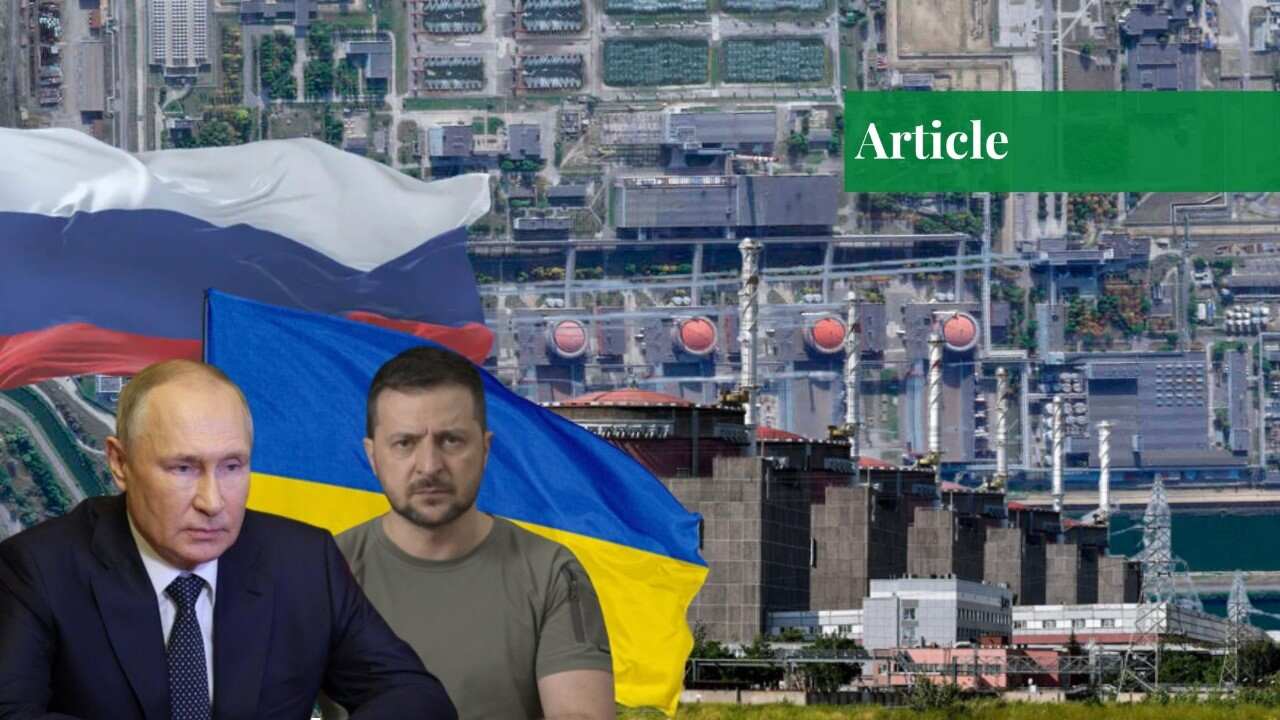Introduction
The Zaporizhzhia nuclear power plant is operated by a state company, Energoatom. The power plant has six power units with a total capacity of 6,000 MW. It holds significant importance for Ukraine as it fulfills 23% of all electricity demands within the country. However, since the war in Ukraine began, several damages and shelling have rendered the power plant inoperable.
Within the first phase of the war, the Russian forces took control of the Zaporizhzhia nuclear plant, occupying all the nuclear facilities located in the north of Ukraine and the southeast of Zaporizhzhia. The nuclear safety of the region is at high risk and a matter of great concern as there are immense chances of further shelling by the Russian forces on the plant. As winter approaches, access to energy will become increasingly important and is likely to be increasingly weaponized, as is being seen with the supply of gas to Western Europe.
Dynamics & Structure of Zaporizhzhia Nuclear Powerplant
Ukraine’s 15 reactors are located in four separate plants. All 15 reactors are water-water energy reactors, which means they are water-cooled and water-moderated. Out of the fifteen reactors, the Rivne plant is the home to four reactors, in northwest Ukraine near the Belarus border. Two are in the Khmelnytskyi plant and three reactors are in the South Ukraine plant.
The remaining six reactors operate in the giant Zaporizhzhia plant. The average fuel burn-up of the nuclear fuel used over the last 20 years at Zaporizhzhia is 44-49GWd/tHM. In case of any radioactive gases released at Zaporizhzhia as a result of any devastating event, the harmful impacts of that would not only affect Ukraine but also its neighboring states.
The Zaporizhzhia plant was built by the Soviet Union near the city of Enerhodar, on the southern shore of the Kakhovka Reservoir on the Dnieper river. It is about 200 kilometers from the contested Donbas region and 550 kilometers Southeast of Kyiv. As it was built in Ukraine, it naturally became an asset of the country.
The Zaporizhzhia nuclear power plant contains six reactors, with six GW of total installed capacity. The first five were successively brought online between 1985 and 1989, and the sixth was added in 1995. This amount of electricity is sufficient to power 4 million houses in Ukraine.
Moreover, it contains large amounts of used nuclear fuel and radioactive materials. The power plant produces half of Ukraine’s total electricity procured from nuclear energy and approximately a fifth of the country’s total electricity generation. Thus, an immensely valuable asset to the country.
The 2014 Incident
On December 03, 2014, the Zaporizhzhia nuclear power plant experienced a minor incident where a short circuit in its power outlet system was reported by the Prime Minister of Ukraine, Arseny Yatseniuk. As a result, one of the six reactors was shut down twice. This incident along with a shortage of coal for the coal-fired power stations led to blackouts in the country which lasted the entire of December.
Situation after the War Between Russia and Ukraine
Zaporizhzhia plant holds great strategic importance for Russia. The plant is just about 200 km (125 miles) from Crimea, which Russia annexed in 2014. When the war initially began on February 20, 2022, the Zaporizhzhia nuclear power plant was working properly without any hindrances. After the Russian invasion of Ukraine began, Energoatom shut down Units 5 and 6 to reduce the risk of nuclear catastrophe, keeping Units 1 to 4 in operation.
This did not last for long as Russian troops began targeting the nuclear power plant in March. Zaporizhzhia was fired on by an anti-tank missile to destroy the infrastructure and disconnect it from Ukraine’s energy grid. Consequently, a conflagration erupted in one of the training facilities outside of the main complex. The fire did not impact reactor safety or any other essential equipment.
Although the plant did lose 1.3 GW of its 6 GW capacity, Russia declared full annexation of the power plant but continued to allow Ukrainian employees to operate the plant. On August 25, 2022, an overhead power line was broken, disconnecting the plant from the power grid. In an emergency operation, the Ukrainian Nuclear Regulatory Commission reconnected the line and restored the connection.
It is believed that the main purpose of taking over the nuclear power plant was to further enfeeble the country. However, there are conspiracy theories circulating that Russia intends to integrate the power plant into the Russian grid through Crimea. Although that does seem like a possible approach Russia would take, according to a senior official at Ukrenergo, Mariia Tsaturian, that would be a complex and difficult task and would require disconnecting and connecting one line at a time while maintaining a 50 Hertz frequency at the grid to prevent outages and further damages.
These theories were repudiated when conspicuous damage to the nuclear power plant was observed. Russia gainsays responsibility regarding any damages caused to the power plant and claims that Russian troops were deployed there to protect it.
Significance of Ukraine’s Major Nuclear Powerplant
According to the World Nuclear Association, approximately half of Ukraine’s electricity comes from 15 nuclear reactors at four plants across the country. The Zaporizhzhia nuclear power plant alone holds significant value for Ukraine as it generates electricity which is ultimately exported to the European Union and utilized for the masses.
Up until September 11, 2022, Ukraine was able to produce an ample amount of energy that would be used to meet the demands of the population during the winter season. Ukraine has been exporting electricity to several European Union countries through transmission lines in Romania and Slovakia. The monetary resources earned from the exporting are utilized to repair lines and power plant units and to purchase coal.
The Situation in September 2022
On 3rd September, 2022 an International Atomic Energy Agency (IAEA) delegation visited the plant to assess the damage and condition of the power plant. Subsequently, on 6 September, a report was published documenting the damage and potential threats to plant security caused by external shelling and the presence of deployed troops near the premises of the plant.
On 11th September, 2022, the final reactor that was working properly was disconnected. The power plant was completely shut down to mitigate the possibility of a nuclear catastrophe. Moreover, Russia declared the annexation of the Zaporizhzhia nuclear power plant and kidnapped employees that were working there without any justification for their actions.
According to IAEA, the shelling of the power plant could trigger a radiation leak, which would ultimately be a nuclear disaster with social, environmental, and health impacts that will remain for years after the incident occurs. Ukraine is fully cognizant of the consequences of any explosion or fire at the nuclear plant, as the country suffered from the most horrible nuclear accident in April 1986 at Chernobyl, which resulted in the spread of radioactive material across the whole continent of Europe.
The impacts of the Chernobyl nuclear accident impacted 350,000 Ukrainian people who had to evacuate their homes amid severe radiation risks. Subsequently, the United Kingdom after 26 years, in 2012, lifted the monitoring of livestock grazing on land that got contaminated by the Chernobyl accident.
The IAEA has noted that the explosion of Zaporizhzhia would equal six Chernobyls, a Ukrainian nuclear reactor that caused a disaster in 1986. Thankfully, no such nuclear incidents have occurred so far since the onset of the Russo-Ukrainian war. Furthermore, a decrease in exports would negatively affect the already fragile economy of Ukraine. Besides exports, the internal demand for energy will increase as winter approaches, resulting in widespread outages in Ukraine.
2023 July Updates on Ukraine’s Zaporizhzhia Nuclear Powerplant
On 4th July, 2023, Russia and Ukraine accused one another of conspiring to launch an attack on Europe’s largest nuclear power plant. The International Atomic Energy Agency (IAEA) has frequently warned of the possibility of a disaster resulting from neighboring military engagements.
The following day the United Nation’s nuclear watchdog, International Atomic Energy Agency, said, “Experts present at Ukraine’s Zaporizhzhya Nuclear Power Plant (ZNPP) have in recent days and weeks inspected parts of the facility – including some sections of the perimeter of the large cooling pond – and have also conducted regular walkdowns across the site, so far without observing any visible indications of mines or explosives.” The IAEA specialists have sought additional access to certify the absence of explosives or mines at the site. Access to the plant’s cooling system and various portions of the turbine halls, as well as to the rooftops of reactor units 3 and 4, is particularly crucial.
Conclusion
The Zaporizhzhia nuclear power plant, the largest in Europe and crucial to Ukraine, has been under Russian control since March 2022. Ukraine relies heavily on its nuclear power plants for energy and if one asset that significantly contributes to electricity generation is destroyed or ceases operation, it would have devastating repercussions for Ukraine. The severely debilitated country has already witnessed the consequences of a nuclear power plant malfunction in 2014.
In 2022, the extent of the damage has increased. The country risked nationwide power outages and decreased export funds since it wouldn’t have had the necessary means to generate an amount that can be utilised for various needs. However, amidst the current scenario, the IAEA has warned that shelling the plant could trigger a radiation leak, causing devastating consequences for Ukraine and the surrounding region. The situation at the plant remains tense, with a real risk of a nuclear disaster. The IAEA has called on Russia to allow unimpeded access to the plant for experts to assess the damage and ensure the safety of the site. The plant is a ticking time bomb, and the consequences of an explosion would be catastrophic.
The latest IAEA updates indicate no visible indications of mines or explosives at the site, but experts still need access to key areas to certify its safety. Russia and Ukraine have accused each other of plotting to attack the plant, highlighting the need for a peaceful resolution to the conflict. The situation at Zaporizhzhia serves as a reminder of the dangers of nuclear power and the importance of taking steps to ensure the safety of these facilities. The world cannot afford another Chernobyl.
If you want to submit your articles and/or research papers, please check the Submissions page.
The views and opinions expressed in this article/paper are the author’s own and do not necessarily reflect the editorial position of Paradigm Shift.




















